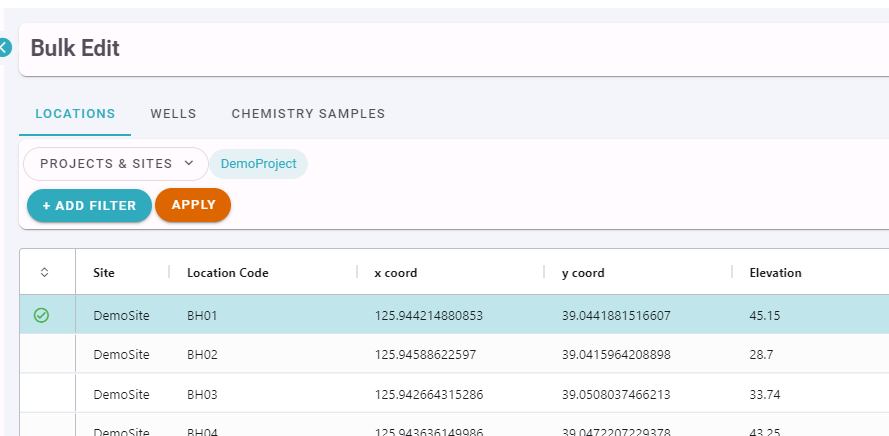Bulk Import & Edit - Locations, Wells & Chemistry Samples
Users who don't have the Data Migration Manager will have basic Import / Update and Export functionality.
Users will be able to bulk import or edit Locations and Wells. Users will also be able to bulk edit certain columns related to Laboratory or Field Portal loaded Chemistry Samples (such as the Sample Location). Functionality for import of historical data from Excel requires the Data Migration Manager.
Importing Locations or Wells
Data can be entered or pasted directly into a worksheet in the browser, or blank Excel Import Templates can be downloaded, populated, then uploaded.
If selecting Locations or Wells the user will see a blank worksheet they can enter or paste data into.

Drop-Downs are available to validate the data.

Alternatively, an empty Excel workbook can be generated using the Download Empty button. The Excel Workbook can then be populated and then uploaded via the "Populated Import Template" option on the initial form.
To import data the user will need to specify a Project for which they have Add Permissions. If the user is looking to update/overwrite existing data they will need to specifiy a project for which they have Edit permission.
 | Add | Add new records. Rows will only be processed if the record does not already exist. |
| Overwrite | Overwrite existing records. Rows will only be processed if the record already exists. Any existing data for the row will be overwritten, including with null values (meaning a value in the database will be overridden, potentially by an empty value). | |
| Update | Update existing records. Rows will only be processed if the record already exists. Existing data for the row will be updated where a cell has a value. Empty cells will be ignored (meaning any existing data in the corresponding field already in ESdat will remain unchanged). | |
| Add/Update | Add/Update existing records. Rows will be processed as an Update if the record already exists, else will be Added. The Update executes as described above. |
Prior to importing the data into ESdat, you may choose to validate the data in your form. This will validate your data against the existing data in ESdat and provide any error messages based on your selected import option.
The validation checks for the following:
- Required fields and must be populated with data.
- Correct Data Types, for example the numerical field of x_coord must only contain numbers.
- Field lengths are enforced
- Duplicate data such as multiples of the same Location code will not be imported.
- If the record is already present in the database then it can not be added, an update or overwrite needs to be used.
- Invalid reference data will not be imported. For example if an unknown monitoring zone, site or Project is referenced on a Location it will be Reported as an error.
- The logged in user must have add permissions for the projects they are importing data against, and edit permissions for the project if they are updating.
- If a new site and project association is made in the data upload it will be highlighted for confirmation before being created in the system.
If any of these checks fail a count of all the import errors are displayed to the user and highlighted on a per row basis as in the example below:

Successfully validated data will be imported, while rows with errors will be flagged and not imported. Once you have resolved any Validation issues, click the Import button to import the data into ESdat.
Bulk Editing Locations, Wells or Chemistry Samples
Users will be able to bulk edit Locations and Wells and Chemistry Samples.

Greyed out columns reflect the unique keys for the data and cannot be edited. All other (white) fields can be modified by either typing your value, using the drop-down lists, or filling down.
Successfully updated rows will show a green check in the far left column.


